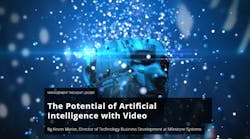“The Edge” is a phrase that is synonymous with infrastructure and devices that are structured to deliver data and metadata from anything and everything outside the walls of one’s domain. The great race of IoT and IIoT expansion into the global economy is being driven by the thirst for information that can expand and define a business’s success or failures with Data. These devices that constitute the vehicle that rides on this infrastructure are a key factor for future growth in an extremely complicated world. Tied to this expansion is the use of AI or more commonly known as deep learning and machine learning.
However, the deeper you go the more complicated it becomes especially with the use of neural network and inference engine capabilities. Most would say that this ecosystem is a world in and of itself within the expansion of security in the modern day. Nonetheless, this is becoming a more commonly phrased idea and one that is finding its way into specifications and RFPs in the security industry rather than the outlandish concepts of safe cities and smart cities of old. Today the intelligent infrastructure that is supporting and re-defining the safe cities and smart cities world is pushing “The Edge” as the cohesive element that brings IT, OT, and physical security together in a converged and interconnected world.
What Drives Us to the Edge
Currently, most organizations, from SMB to Enterprise have some form of edge infrastructure to support cameras, sensors, access control, etc. What they may not know is its effect on the business. Edge today allows for a great deal of data to help a business create efficiencies as well as manage overall metrics around employee safety, business process, as well as operations. The desire for more edge-centric infrastructure is tied directly to data and metrics, and therefore value. From marketing to lean processes organizations are using this growth in edge infrastructure to reach areas of their operations within the building and beyond.
Historical Perspective
Stakeholders in the physical electronic security industry have been witness to several cycles of the architecture of systems shifting from centralized processing to the edge, back to centralized processing, etc. From the 1950s to 2019 the trends were logically driven by changes in technology, threats and the costs associated with solutions to mitigate risk.
From 1950 through the early 1980s, most commercial access control field devices (i.e.: card readers and door controllers) and video cameras collected information and communicated analog data via hard wire to an “On-Premise” CEB (Central Electronics Bank) for processing, monitoring and decision making by human operators.
The first big move to the edge came when access control field panels were developed to hold enough information to control entry without having to communicate in real-time with the CEB. Video evolved from analog to digital to IP but took much longer to shift processing intelligence to the edge due to the magnitude of the date created. Primitive video analytics could run at the edge, but more sophisticated analytics needed the processing power of centralized servers. In the early 2000s, IP devices evolved to be smaller and cheaper and compression algorithms reduced file sizes to where IT departments started permitting the use of corporate networks and/or the internet for communications.
The move to the edge seemed inevitable until cyber-attacks and the exponentially increased threat to the security of communications caused many stakeholders to pause and question that just because you can do something, should you and what are the consequences? Cloud services were looked at with additional scrutiny as another new risk area like the internet. From 2015 through 2019 technological advances to mitigate cyber risk were followed by a worldwide pandemic that forced the utilization of cloud services much faster than it would otherwise have occurred. All security industry stakeholders have scrambled to keep up with a speed of innovation the industry has never witnessed.
According to Steve Caroselli CEO of Orion ECI, unprecedented numbers of (non-video) IoT sensors are being deployed into enterprise facilities sharing data across business units including security, IT, facilities and other related PropTech.
“This new paradigm of multi-streaming devices with onboard AI / Inference Engine capabilities has had no clear path to deliver meaningful data through the legacy middleware panels. the latest in edge computing delivers IoT edge data directly to both daily practitioners and C-Suite data mined reporting for better daily decision making,” he said.
Jim Henry, a Senior Consultant with ButchkoESI adds: “The sophistication of video analytics, the ability to run them at the edge and to securely communicate to infrastructure in the cloud that can maintain security at a much lower cost
have triggered what may well be the last ‘March to the Edge’ in the architecture of physical electronic security systems. This ‘March’ (unlike those before it) promises to be much more of a ‘race’ as is now both economically and technically compelling for systems of any size or scale. All stakeholders (end users, consultants, manufacturers and systems integrators) who want to not only survive but thrive in the 2020s (and beyond) need to position their companies to align with this new industry standard.”
What is the Answer?
The final race to the edge is the culmination of over 60 years of technological development applied to the human condition. From terrorist acts to a global pandemic, the world has faced extreme challenges. With this is the desire to communicate and interact safely with the use of technology to do so. What is the roadmap and how do we define success that drives the new model of Edge converged technology?
“The Edge has opened up opportunities for increased business intelligence and data sharing across company stakeholders. This revelation has allowed end-users, from smart cities to companies large and small, to increase customer and employee experiences and therefore create measurable value to the organization,” explained Jon Polly, PSP, the Chief Solutions Officer at ProTecht Solutions Partners.
The primary challenge is to define what the edge truly is. This has been defined by the security industry as any technology that sits at the edge of infrastructure such as a camera, and access control point, a sensor, or any other device that detects or communicates metadata from an exterior or external control point beyond the internal network. This has been one of the concerns for internal IT and cyber teams because the potential loss of control of the external device inevitably becomes a threat to the overall system.
Many have attempted to solve this with micro-segmentation or complete air-gapped or fully segmented external networks. All of which is still the objective. However, I believe this final march to the edge incorporates much more and has birthed a new model which is a siloed compartmentalized infrastructure that is being built as its very own ecosystem – an Enterprise of Things (EoT consisting of IT, IoT and OT technologies). The development of purpose-built infrastructure for the edge with software native to the edge serving only to support the new domain of IIoT has become integral to the understanding of the “new edge.”
The power of this new domain is its ability to establish complete security and complete control of its own infrastructure. This incorporates intelligent cameras, sensors, Operational control systems such as smart valves, mobile communications systems, and edge-based secured cloud infrastructure. The impetus to this final edge paradigm shift is the birth of the use of machine learning, deep learning algorithms, neural networks and inference engines across CPU, GPU, VPU and FPGA. This has been driven by the thirst for data by business interests but has become the gateway for this new purpose-built infrastructure at the edge.
“The Enterprise of Things (EoT) ecosystems will require the implementation of much-needed holistic tools to manage end-to-end the ecosystem, from Core to the Edge devices; regardless of communication technologies or manufacturers. The end-user will create efficiencies and reduce vulnerabilities; the security integrator will lose some amount of control which is already being felt today,” concluded Polly.
The inevitable consequence of this self-sustaining ecosystem is that it will greatly affect the purpose of middleware in the marketplace. As most end users begin to take advantage of the growing trend, they will look at creating efficiencies within their use of technology. One of which is the migration to this new edge ecosystem.





